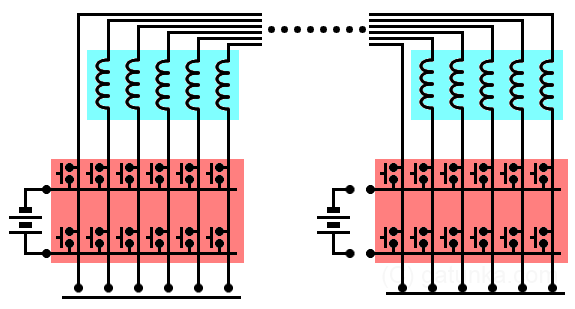5 Needle Indicating Telegraph – US Patent 1622
The Wheatstone needle telegraph operated based on 5 needles that could tilt to the left or right. Owing to the simplicity of the device, there’s not much detail to show. However, the design is interesting in how it differs from how we would build a similar device using modern ideas. First, here is a picture of an actual telegraph machine (from Wikipedia):

Note that there are 5 needles and 6 pairs of buttons. If we were going to build this kind of communication device today, we would consider that 5 needles means 5 signal lines, and the ability to swing left, swing right, or remain vertical could be produced using a simple positive/zero/negative (or -1/0/1) signaling system. Of course, this is a consequence of us having a solid understanding of the concept of electrical signaling. Back in the 1830s they didn’t have this concept, but instead thought about things in terms of electrical circuits, where you have to build a circuit extending from the positive terminal to the negative terminal of the battery. The electrical circuit is thus less direct and less flexible.
First, let’s look at the needles. These were operated by electromagnets behind the plate with the letters on it. One terminal of each magnet was connected to the telegraph wires that ran off to the remote station, and the other was connected through to the buttons at the front. At the receiving station, a metal bar was connected that joined all of the conductors together. The sending station then simply connected one needle to the positive end of a battery, and another needle to the negative end, producing a circuit which deflected the needles. Here is a schematic of the arrangement:

The left side is the sending station and the right side is the receiving station. At the transmitting station, a battery is connected to rails underneath the buttons (shaded pink), but this is disconnected at the receiving station. Furthermore, the rail at the very bottom is disconnected at the sending station but connected at the receiving station. The magnets which drive the needles are indicated by the blue area. Since the sender needs to create a circuit, they always have to press two buttons on the sending station, one to connect to the positive terminal of the battery and one to connect to the negative terminal. This is where the difference from regular signaling comes into play. It is not possible to simply send a single +1 or -1 signal to the receiver. We always have to have one +1 and one -1 signal to form a circuit. This is why a sixth set of buttons that is not connected to any needle is required. If we only want to move a single needle, we need to use this sixth set of buttons to form a return circuit that bypasses the needles. Here is a diagram of the some of the parts from the original patent.

At this point, I guess the problems with this system are quite clear. The first is the efficiency in terms of wires. 6 wires are needed in order to send 30 codes. Part of this comes about because of the circuit style of thinking instead of signal style of thinking. If we were using signals instead, we could have a common ground connection and use the five wires as signals relative to this. This would enable us to get rid of one wire.
The second problem is that of repeaters. Since we require circuits, the individual lines cannot be repeated by regular repeaters. Instead, we need to construct special circuitry for repeater stations.
Owing to these problems, the five needle system did not last long, and was eventually replaced by 2-wire/2-needle, and then 1-wire/1-needle systems that employed Morse code.
Related Posts
Tweet